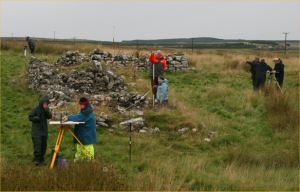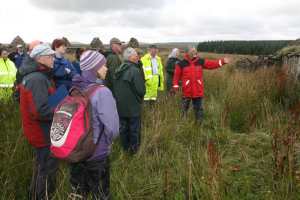|
Scotlandís Rural
Past Team Comes To Caithness
13 September 2009 Most of the croft-houses and steadings still visible in the landscape date to the 19th century. Many of these buildings were recorded to a limited degree by the first Ordinance Survey of the 1870s. However their remit was to record only those building that stood above knee height. Unfortunately most farmsteads built before about 1800 were constructed from turf on stone footings; too low to meet the Ordinance Survey criterion of knee high or above. The Royal Commission on Ancient and Historic Monuments of Scotland (RCAHMS) is doing what it can within its limited resources to rectify this situation but it needs our help. To this end the commission set up a five year project called Scotlandís Rural Past project (SRP) which aims to train local enthusiasts in recording the remains of abandoned rural farming settlements before they are lost forever by natural decay and by rural development. Many local volunteer groups have been established elsewhere in Scotland but one is needed to cover Caithness.
In our case we worked on the township of Broubster that was cleared in 1839 to make way for sheep. We started our fieldwork by looking at Broubster Village Square, which was built by the estate to house the population cleared from old Broubster. Here we looked at safety issues in surveying old buildings and at evidence for construction methods, building use including change of use. We then moved to the more ruinous site of old Broubster to put what we had learned into practice. There were three elements to the recording process, making a sketch plan, photography and plane tabling. We began by learning to make a sketch plan of the site. Sketch plans are seen as important because they require more detailed observation than photography alone. This is done by pacing out the form of the buildings, sketching them as a simple scale plan and adding descriptive notes on particular building features such as cruck slots, cupboards and butt-joints. Butt-joints and slight changes in wall alignment can indicate different periods of construction. The principle recording method we learned is called plane tabling. It produces an accurate measured plan of a site using very simple equipment which is easy to use. The plane table is simply a rectangular board mounted horizontally on a tripod. An ordinary dressmakerís pin is stuck in the board and an alidade used to sight from the pin to a point on the building such as a corner. A line of sight is then drawn on the plan (called a ray). The distance is measured from the pin to the sight point on the building; this is marked off on the ray to the chosen scale to form a point. The process is repeated for salient points on the building; the points are joined up by lines and hey presto a building plan. I think that most if
not all of the 18 participants (and the wasp) found the training
interesting and enjoyable. We are looking to form a local group to put
the recording into practice. If you would be interested you can contact
us through Caithness Archaeological Trust at: or Paul Humphreys 01847 851 275 p.humphreys@btinternet.com |

